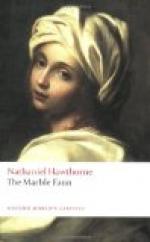“This was a prisoner’s cell in the old days,” said Donatello; “the white-bearded necromancer, of whom I told you, found out that a certain famous monk was confined here, about five hundred years ago. He was a very holy man, and was afterwards burned at the stake in the Grand-ducal Square at Firenze. There have always been stories, Tomaso says, of a hooded monk creeping up and down these stairs, or standing in the doorway of this chamber. It must needs be the ghost of the ancient prisoner. Do you believe in ghosts?”
“I can hardly tell,” replied Kenyon; “on the whole, I think not.”
“Neither do I,” responded the Count; “for, if spirits ever come back, I should surely have met one within these two months past. Ghosts never rise! So much I know, and am glad to know it!”
Following the narrow staircase still higher, they came to another room of similar size and equally forlorn, but inhabited by two personages of a race which from time immemorial have held proprietorship and occupancy in ruined towers. These were a pair of owls, who, being doubtless acquainted with Donatello, showed little sign of alarm at the entrance of visitors. They gave a dismal croak or two, and hopped aside into the darkest corner, since it was not yet their hour to flap duskily abroad.
“They do not desert me, like my other feathered acquaintances,” observed the young Count, with a sad smile, alluding to the scene which Kenyon had witnessed at the fountain-side. “When I was a wild, playful boy, the owls did not love me half so well.”
He made no further pause here, but led his friend up another flight of steps—while, at every stage, the windows and narrow loopholes afforded Kenyon more extensive eye-shots over hill and valley, and allowed him to taste the cool purity of mid-atmosphere. At length they reached the topmost chamber, directly beneath the roof of the tower.
“This is my own abode,” said Donatello; “my own owl’s nest.”
In fact, the room was fitted up as a bedchamber, though in a style of the utmost simplicity. It likewise served as an oratory; there being a crucifix in one corner, and a multitude of holy emblems, such as Catholics judge it necessary to help their devotion withal. Several ugly little prints, representing the sufferings of the Saviour, and the martyrdoms of saints, hung on the wall; and behind the crucifix there was a good copy of Titian’s Magdalen of the Pitti Palace, clad only in the flow of her golden ringlets. She had a confident look (but it was Titian’s fault, not the penitent woman’s), as if expecting to win heaven by the free display of her earthly charms. Inside of a glass case appeared an image of the sacred Bambino, in the guise of a little waxen boy, very prettily made, reclining among flowers, like a Cupid, and holding up a heart that resembled a bit of red sealing-wax. A small vase of precious marble was full of holy water.




